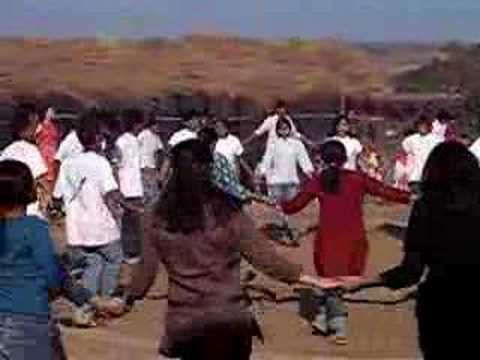Western Folk Dance at Sahyadri School
“How beautiful are the feet of the messengers living atop a hill, bringing good tidings, and proclaiming peace.” That’s how Mahesh Pande, Mahesh sir to us, translates the lyrics of ‘Manavu’, the Israeli folk dance that brings our Saturday Folk Dance evenings to a close. “There’s a flame burning within each of us,” he explains. “Each of us brings our own light. There’s a lot of joy and togetherness when we come together.” In the hush at the end of Manavu, the dancers stand in a ring, holding hands, gazing at the flame of a candle in the centre for a minute. The candle is snuffed out with the fingers as the dancers quietly leave the dance hall.
The swirling movements and lilting music that fill the Senior Audi every Saturday evening have become a much-loved and joyous tradition at Sahyadri, thanks to the pioneering efforts of Mahesh sir, himself the messenger who brought Western Folk Dance to Sahyadri, back in 1997, when the school was still in its infancy. Even today, Mahesh sir comes back to school each year to initiate Class 8 into the tradition through a much-awaited three-week workshop. Speak with him, and he will share with a smile the story of his travels across Eastern Europe, undertaken with the express aim of picking up and compiling a range of folk dances that he could then impart to children in other places.
Ask students what they like about this activity, and you get a variety of responses. “It’s a good place to be, where the school comes together.” “It’s a stress-buster.” “It helps us mix up with others and feel more comfortable with them.” “It’s a fun way to exercise.” “It makes you feel very happy, comfortable, and free.” “You lose your awkwardness; boys and girls mix freely.” These comments capture the strands that make this space meaningful for students.
Picking up the dances involves developing physical co-ordination, rhythmic movements, balance, an ear for changes in the music, grace in one’s carriage and motion, as well as social skill in keeping attuned to others whom you partner with. It necessitates keen attention and focus, as one changes poses, formations, spatial position, and partners. Moving in synchrony with others brings a sense of joy and harmony. Dancing provides the opportunity to enhance body awareness, proprioception, and socialization. More than everything else, dancing is spontaneous, joyous, and relaxing. It brings people together; ex-students who visit are thrilled to join the folk dance again and feel the sense of connectioncohesion it brings.
Among other benefits, the dances also acquaint students with a different culture, hailing as they do from different countries, mainly in Europe. During Folk Dance sessions, held from 6 to 7:45 p.m. every Saturday, students dance the full repertoire of 34 dances, including Mayim and Hanokdim from Israel, Ceuleandra and Alunelul from Romania, Doudlebska Polka from Czech Republic, Troika from Russia, Tarantella from Italy, Circassian Circle from Northern Caucasus, Karaguna from Greece, Corrido from Mexico, and so on. In the process, the dancers go through the gamut of steps and poses learnt from Mahesh sir, beginning with the different holds, moving through side steps, kinds of balance, the grapevine, the swing, the promenade, the single and double arcs, the pas de basque, the different locks, and so on, to the basket, goose steps, dosido, and so on. An entire syllabus of folk dance gets covered, giving students an introduction to the social graces and conventions of far-flung places.
The juniors watch this weekly spectacle all agog, impatient for their turn to pirouette, swing, and step out in style.

